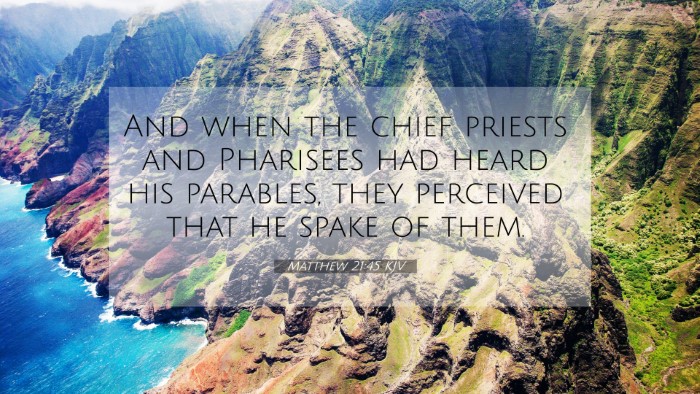Understanding Matthew 21:45
Bible Verse: Matthew 21:45 - "And when the chief priests and Pharisees had heard His parables, they perceived that He spoke of them."
Overview of the Verse
In this passage, Jesus delivers parables that confront and critique the religious leaders of His time—specifically the chief priests and Pharisees. This moment signifies a turning point where the religious authority recognizes the implications of His words, acknowledging that Jesus is directing His message at them. This realization speaks volumes about the challenge posed by Jesus to the established religious order.
Commentary Insights
- Matthew Henry's Commentary:
Henry notes that the chief priests and Pharisees, though leaders in spiritual matters, are blind to their spiritual state. Their perception of Jesus’s parables reflects their guilt and the honesty of their hearts. They cannot escape the conviction of rejection and their need for repentance.
- Albert Barnes' Commentary:
Barnes emphasizes the intention behind Jesus’s parables, seeing them as a form of divine judgment against those who should have been the foremost examples of godliness. Barnes highlights that the leaders had indeed perceived the direct implications of His teaching and thus demonstrated their awareness of their failings.
- Adam Clarke's Commentary:
Clarke interprets the verse as a revelation of the spiritual blindness of the Pharisees. He notes that their recognition of being the subjects of the parables incited further animosity rather than repentance, illuminating the persistent theme of hard-heartedness among the leaders of the Jews.
Connections to Other Bible Verses
This verse establishes various connections with other Scripture passages, providing a thematic understanding that enhances the coherence of biblical teachings.
- Isaiah 5:1-7: A parable about a vineyard that symbolizes Israel’s neglect of God's commandments, paralleling the themes in Matthew 21.
- Matthew 21:33-44: The Parable of the Wicked Tenants explicitly outlines the rejection of God’s messengers.
- Luke 20:19: This account reflects the awareness of religious leaders regarding Jesus's criticisms, confirming their understanding.
- Romans 11:20: Paul speaks of the consequences of unbelief among the Israelites, relating to the acknowledgment by the Pharisees.
- 1 Peter 2:4-8: The reference to Christ as the cornerstone ties back to the rejection spoken of in the parables, showing continuity in biblical themes.
- Hebrews 3:7-19: Reflects on the hardening of hearts against God's voice, which correlates with the actions of Pharisees upon hearing the parables.
- John 10:26: Jesus criticized the unbelief of those who refuse to recognize Him despite clear evidence of His divine authority.
- Acts 7:51: Stephen accuses the Jews of resisting the Holy Spirit, indicating the ongoing disobedience showcased by the leaders during Jesus's ministry.
- Revelation 3:20: This verse echoes the idea of hearing and responding, drawing a connection between God’s calling and the resistance encountered in Matthew.
- Matthew 5:14-16: This passage speaks to being a light, which contrasts with the blindness of the Pharisees when faced with Jesus's revelations.
Thematic Summary
The comprehensive understanding of Matthew 21:45 highlights several significant themes:
- Spiritual Blindness: A recurring motif in Scripture is the inability or unwillingness of the religious elite to recognize their shortcomings and the truth in Jesus's teachings.
- God’s Judgment:The parables serve as both a warning and a form of judgment upon those in authority who mislead God’s people.
- The Call to Repentance: Jesus’s words invite his audience, including the Pharisees, to self-reflection and repentance.
- Revelation of Truth: The acknowledgment by the Pharisees reflects the broader truth that God reveals Himself even to those who resist Him.
Inter-Biblical Connections and Practical Tools
Understanding the connections between Bible verses requires effective tools and methods for cross-referencing:
- Bible Concordance: A useful resource for finding related verses and understanding key themes.
- Cross-Reference Bible Study: Engaging with texts that reference or are referenced by each other can yield deeper insights.
- Bible Reference Resources: Utilize guides and systems to identify and explore thematic connections.
- How to Use Bible Cross-References: Learning techniques to trace themes across both the Old and New Testaments enriches understanding.
- Identifying Connections: Engaging in a detailed study of inter-Biblical dialogue can clarify contextual relationships.
Conclusion
The verse Matthew 21:45 serves as a pivotal point in the narrative of Jesus's teachings, acting as a mirror to the spiritual condition of the Jewish leaders. This understanding, supported by insights from esteemed commentaries and cross-referenced biblical texts, allows believers and scholars to appreciate the richness of Scripture and how different parts of the Bible speak to one another in profound ways.





